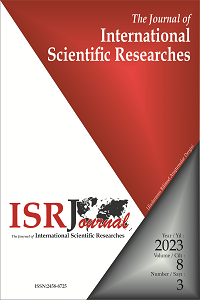Abstract
References
- Akgündüz, D., & Ertepınar, H. (2015). STEM Eğitimi ve Türkiye Raporu. İstanbul: Scala Basım.
- Barnett, W. S. (1995). Long-term effects of early childhood programs on cognitive and school outcomes. The future of children, 25-50.
- Boston Children's Museum. (2013). Boston: Peep and the Big World. http://stemakademi.com.tr/medanis_bizibiz/egitim-programlari/
- Clayton, T. (2016, December). Tech in America. http://techinamerica.com/importance-engaging-children-stem-education/ adresinden alınmıştır
- Chuderski, A. (2013). When are fluid intelligence and working memory isomorphic and when are they not?. Intelligence, 41(4), 244-262.
- Dee, T. S., & Jacob, B. (2011). The impact of No Child Left Behind on student achievement. Journal of Policy Analysis and Management, 30(3), 418-446.
- Education in Technology. (2016). http://www.egitimdebilisimteknolojileri.com/stem-nedir-stem-egitimi.html
- Erdoğdu, N. (2016, Eylül 15). Aralık 22, 2016 tarihinde http://blog.classloom.com/tr/21-yuzyil-becerileri-stem-ve-kocluk-iliskisi/ adresinden alındı
- Eshach, H., & Fried, M. N. (2005). Should science be taught in early childhood?. Journal of science education and technology, 14, 315-336.
- Freeman, R. B., & Huang, W. (2015). China’s “Great Leap Forward” in science and engineering. In Global Mobility of Research Scientists (pp. 155-175). Academic Press.
- Honey, M., Pearson, G., & Schweingruber, H. (2014). STEM integration in K-12 education: Status, prospects, and an agenda for research. National Academies Press.
Abstract
Developing and changing technology brings with it different business opportunities. This change in the field of work also affects the education models in schools. With this study, he examines the importance and necessity of STEM (Science, Technology, Engineering and Mathematics) education and follows its development and impact in various countries. Emphasizing the importance of STEM for the 21st century workforce, this study offers a holistic approach with the integration of theory and practical application. This study also explores the harmonious relationship between STEM and 21st century skills and draws attention to the need for multifaceted competences in a rapidly changing world. In addition, the relationship between STEM education and multilingualism in our globalized age is discussed and the enhanced linguistic development that STEM can promote is emphasized. The research also provides an insight into Turkey's STEM journey, known as STEM, and reveals the country's initiatives, challenges and the road ahead. In conclusion, this research provides a comprehensive look at the role of STEM in equipping students with the skills, knowledge and adaptability necessary for the contemporary world.
Gold, which is one of the important investment instruments, is followed by many investors around the world due to its impact on the markets. For this reason, the estimation of gold prices and the determination of the affecting factors is one of the important problems. In this study, the percentage change in gold prices and its causes are estimated with hidden Markov models. Gold, dollar, interest and inflation rate data between 2013-2023 were used. Percentage change in gold prices is defined as observations and 18 possible hidden state are obtained from dollar, interest and inflation rates that affect gold prices. The forward algorithm is used to solve the first fundamental problem of the hidden Markov model. Observation sequence probabilities in 2-month periods were calculated with this algorithm. In this period, the probability of the percentage change in gold prices to be greater than 0.5 was found to be 23.6%. Hidden states that best explain the observation sequences are examined with the Viterbi algorithm. It has been observed that high accuracy rates are obtained by comparing the results with real data.
Keywords
References
- Akgündüz, D., & Ertepınar, H. (2015). STEM Eğitimi ve Türkiye Raporu. İstanbul: Scala Basım.
- Barnett, W. S. (1995). Long-term effects of early childhood programs on cognitive and school outcomes. The future of children, 25-50.
- Boston Children's Museum. (2013). Boston: Peep and the Big World. http://stemakademi.com.tr/medanis_bizibiz/egitim-programlari/
- Clayton, T. (2016, December). Tech in America. http://techinamerica.com/importance-engaging-children-stem-education/ adresinden alınmıştır
- Chuderski, A. (2013). When are fluid intelligence and working memory isomorphic and when are they not?. Intelligence, 41(4), 244-262.
- Dee, T. S., & Jacob, B. (2011). The impact of No Child Left Behind on student achievement. Journal of Policy Analysis and Management, 30(3), 418-446.
- Education in Technology. (2016). http://www.egitimdebilisimteknolojileri.com/stem-nedir-stem-egitimi.html
- Erdoğdu, N. (2016, Eylül 15). Aralık 22, 2016 tarihinde http://blog.classloom.com/tr/21-yuzyil-becerileri-stem-ve-kocluk-iliskisi/ adresinden alındı
- Eshach, H., & Fried, M. N. (2005). Should science be taught in early childhood?. Journal of science education and technology, 14, 315-336.
- Freeman, R. B., & Huang, W. (2015). China’s “Great Leap Forward” in science and engineering. In Global Mobility of Research Scientists (pp. 155-175). Academic Press.
- Honey, M., Pearson, G., & Schweingruber, H. (2014). STEM integration in K-12 education: Status, prospects, and an agenda for research. National Academies Press.
Details
| Primary Language | English |
|---|---|
| Subjects | Communication Education, Family Resources Education |
| Journal Section | Articles |
| Authors | |
| Publication Date | October 27, 2023 |
| Submission Date | August 13, 2023 |
| Published in Issue | Year 2023 Volume: 8 Issue: 3 |



